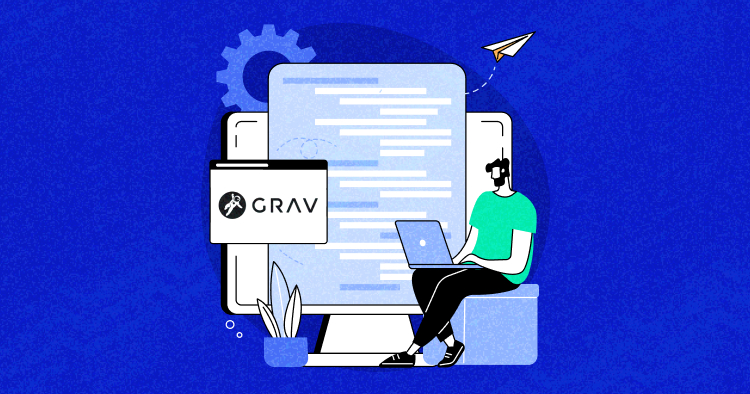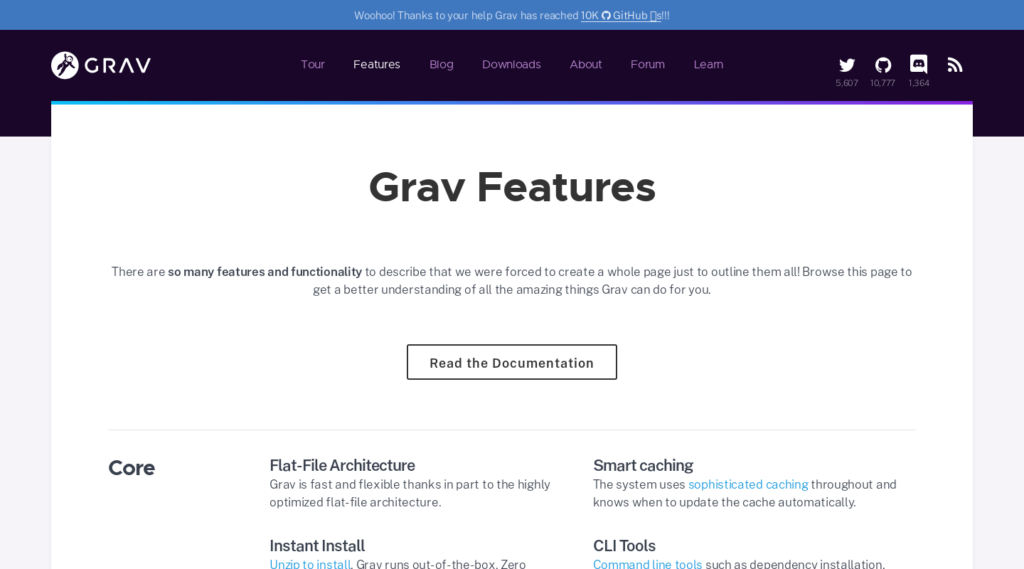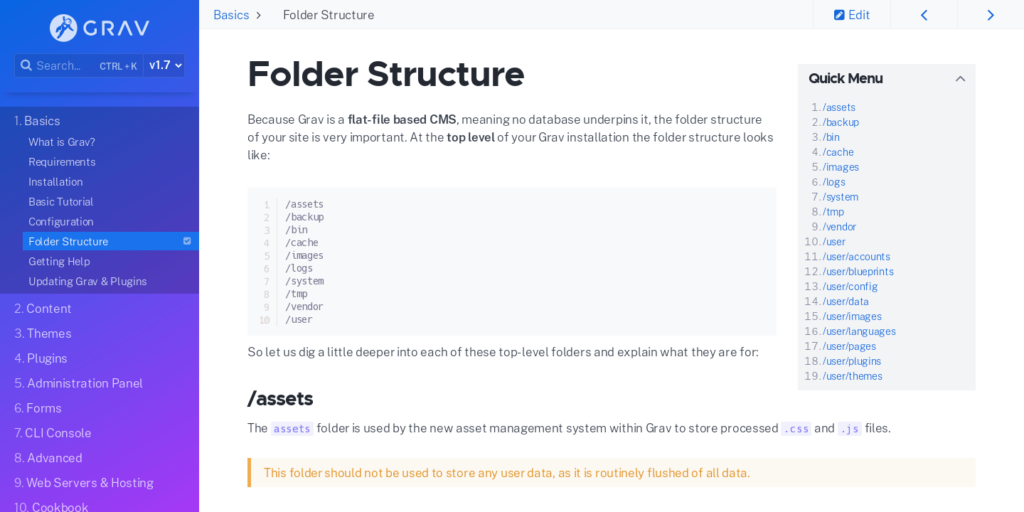
In today’s digital age, a website has become necessary for businesses and individuals. A website allows you to showcase your brand, products, and services to a global audience and to engage with your customers and followers.
With 44K+ websites all over the internet, Grav CMS is one such platform that has gained popularity in recent years due to its modern architecture, speed, and flexibility. Its flat-file CMS makes it lightweight, fast, and easy to use, as there is no need to set up a complex database or deal with complex queries.
In this article, I’ll cover everything you need to know about Grav CMS, from comparison with other CMSs to its easy installation on Cloudways. So let’s get started!
An Overview of Grav CMS

– Source: Grav CMS
Grav CMS stands out from other CMSs because it doesn’t use a database to store content. Instead, Grav uses a file-based approach, meaning all the content is stored as simple text files in a file system. This approach helps achieve easier deployment, simpler backups, and better performance.
It is designed to be lightweight and fast, making it an excellent choice for small to medium-sized websites, blogs, and portfolios. Its powerful plugin and theme systems make it highly customizable. Users can choose free and premium themes and plugins to improve their sites’ functionality and user experience.
It has a modern, intuitive admin panel allowing users to manage content, themes, and plugins easily. It also supports Markdown, a simple and popular markup language, for content creation, making it easy to write and format content without dealing with complex HTML.
Grav CMS Usage Statistics
Grav CMS has gained popularity over the years. While there is no official source of usage statistics for Grav, a few indicators can provide some insight into its favor. According to BuiltWith, approximately 22K+ live websites use Grav CMS as of February 2023.

– Source: BuiltWith
Grav CMS vs Other CMSs
Here’s a quick comparison of Grav CMS with other popular CMSs.
| Feature | Grav CMS | WordPress | Drupal | Joomla | Ghost |
| Programming Language | PHP | PHP | PHP | PHP | Node.js |
| Database | Flat-File | MySQL | MySQL | MySQL | SQLite |
| Content Editing | Markdown | Gutenberg | WYSIWYG | WYSIWYG | Markdown |
| Customization | Themes & Plugins | Themes & Plugins | Modules & Themes | Templates & Extensions | Themes & Apps |
| Learning Curve | Moderate | Easy | Difficult | Moderate | Easy |
| Security | High | High | High | High | High |
| Performance | Fast | Medium | Slow | Slow | Fast |
| Community Support | Good | Excellent | Good | Good | Good |
| SEO | Good | Good | Good | Good | Good |
| Ecommerce Support | Yes | Yes | Yes | Yes | No |
| Multilingual Support | Yes | Yes | Yes | Yes | Yes |
| Price | Free | Free | Free | Free | Paid |
Reasons to Use Grav CMS

– Source: Grav CMS
Grav CMS offers several advantages over other CMSs, making it a popular choice for developers and website owners. Here are some key Grav CMS features that make you use it for web development.
1. Flat-File Architecture

– Source: Grav CMS
Grav CMS uses a flat-file architecture that doesn’t rely on a database. This makes managing and organizing content easier, as it can be easily edited, moved, and backed up without complex database queries.
The flat-file architecture in Grav CMS provides a flexible and scalable approach to content management, which makes it an excellent choice for building modern websites and applications.
2. Modern Technology

– Source: Grav CMS
Grav CMS is built on PHP and uses the Twig Templating Engine, Composer, YAML, and Git, which makes it developer-friendly and customizable. The use of modern technology in Grav CMS provides developers and users with a powerful and flexible CMS that is easy to use and maintain.
3. Multilingual Support

– Source: Grav CMS
Grav CMS supports multiple languages, making creating multilingual websites and applications easy. With its easy-to-use localization tools and customizable language settings, Grav CMS provides a powerful and flexible solution for managing content in multiple languages.
Grav support content localization, URL routing, language switcher, translation plugins, customizable language settings, makes it an excellent choice for creating websites that target a global audience.
4. Plugin System

– Source: Grav CMS
The plugin system is one of the key features of Grav CMS that allows users to extend the core functionality of the CMS. Plugins are packages of code that can be installed and activated within Grav to add new features or modify existing ones.
Plugins can be installed from the Grav Package Manager (GPM) or manually downloaded and installed from the Grav website or other sources. Once installed, plugins can be activated or deactivated from the admin panel, allowing users to test different configurations.
5. Theming System

– Source: Grav CMS
Grav’s theming system is built on top of the Twig Templating Engine, which provides a powerful and flexible way to create templates and layouts. Twig is a popular templating engine widely used in the PHP community and is known for its simplicity, readability, and security.
It has a large and active community of developers who have created hundreds of themes for the Grav CMS. These themes cover a wide range of design styles and functionalities, including responsive design, grid layouts, typography, and more.
5. Admin Panel

– Source: Grav CMS
Grav CMS has an intuitive admin panel that’s easy to use, even for non-technical users. It offers a clean and modern interface allowing users to manage and publish content on their websites easily. Also, it includes a built-in media library, allowing users to easily manage and organize their media files.
The administration panel provides various customizable settings, allowing users to configure their websites to meet their needs. Users can customize settings like site titles, logos, colors, and fonts.
This includes a built-in user management system, which allows users to create and manage user accounts on their websites. Users can assign roles and permissions to different users and control access to specific features and content.
6. Version Control

– Source: Grav CMS
Grav CMS has built-in version control support, which makes it easy to manage and track changes to your website’s content and settings. Grav CMS’s version control system is based on Git, allowing developers to collaborate and track website code and content changes.
During the deployment and upgrade process, Grav CMS automatically generates a backup of the website’s content and configuration files that can be restored if necessary. This feature ensures that modifications can be conveniently reverted in case of errors or issues.
Grav CMS System Requirements
Grav CMS has relatively low system requirements, which makes it accessible to a wide range of users. It can run on almost any computer, including most web hosting providers. The minimum system requirements for Grav are:
- PHP version: 7.3.6 or higher
- Web Server: Apache, NGINX, LiteSpeed, Lightly, IIS, etc.
Looking for a reliable & high-performing hosting for Grav CMS?
With Cloudways, you get access to powerful server infrastructure that is optimized for Grav CMS, ensuring your site runs smoothly and efficiently.
How to Install Grav CMS?
Cloudways allows users to easily deploy and manage applications, including Grav CMS. Here are the steps to install Grav CMS on Cloudways:
- Sign up or log in to your Cloudways account;
- Enter Application & Server Details and choose Custom App as your application;
- Select the server specifications, including the cloud provider, server size, and location;
- Click on Launch Now button to create a new server with the PHP Stack application.

- Click on your newly launched server to proceed to the next screen.

- Go to Server Management → Master Credentials and Launch SSH Terminal .
- Use your Public IP, Username, and Password to access SSH terminal.

- Use PuTTy or Cloudways SSH Terminal to run the Composer command.
- Access the public_html folder with the following commands:
- LS command is used to list files or directories in Linux
- CD is used for changing directories
Please run the following Composer command to install Grav CMS.
wget https://github.com/getgrav/grav/archive/refs/heads/develop.zip

- Wait for the download to finish.
- Unzip the Grav CMS zip file that you have just downloaded.

- Update the webroot to public_html/grav from Applications → Applcations Settings .

- Reset the permissions to the app user from Reset File/Folders Permissions .

- Access the webpage by using the application URL to open the Grav CMS.

- If you see the welcome page (see below), everything has been configured successfully.

There you go! Installing Grav CMS on Cloudways is a simple process you complete in just a few steps.
Pros and Cons of Grav CMS
Grav CMS offers several advantages over other CMSs, but there are also some drawbacks to consider. Here are some pros and cons of Grav CMS:
Pros
- Speed and Performance: Grav CMS is a flat-file CMS, which means it doesn’t require a database to store content. This approach results in faster load times, better performance, and improved security.
- Flexibility and Customization: Grav CMS is highly flexible and customizable, thanks to its powerful plugin and theme systems. You can choose from a wide range of free and premium themes and plugins to enhance your website’s functionality and appearance.
- Ease of Use: Grav CMS has a modern, intuitive administration panel that’s easy to use even for non-technical users. It also supports Markdown, a simple and popular markup language, for content creation, making it easy to write and format content without dealing with complex HTML.
- Developer-friendly: Grav CMS is built on PHP and uses the Twig Templating Engine, which makes it easy for developers to customize and extend the system. It also offers a wide range of APIs and hooks, making integrating with other systems and building custom applications possible.
Cons
- Less Scalable: Grav CMS is more suited for smaller websites and projects that don’t require complex database queries or large amounts of data. It may not be the best choice for large-scale websites with complex needs.
- Limited Support: Grav CMS has a smaller user community and may have limited resources and support compared to more popular CMSs like WordPress.
- Limited Functionality: While Grav CMS offers a wide range of plugins and themes, it may not have the same level of functionality and features as other CMSs like WordPress, especially when it comes to e-commerce, membership, and social networking features.
- Learning Curve: Grav CMS may have a steeper learning curve than more user-friendly CMSs like WordPress. It requires some technical knowledge and familiarity with PHP and Twig.
Summary
With its flat-file architecture, extensive plugin system, and powerful theming engine, Grav CMS provides users with a wide range of customization options and enables them to create unique and appealing websites.
Grav CMS is an excellent for developers who want to create fast, secure, and customizable websites without the complexity of traditional database-driven CMSs. Its active community, along with its extensive documentation, make it a popular choice for developers.
Q. Is Grav a good CMS?
A: Yes, Grav is a good CMS for many use cases. It is well-suited for small to medium-sized websites and offers a powerful and flexible platform for creating and managing websites.
Q. Is Grav secure?
A: Yes, Grav is generally considered to be a secure CMS. The developers of Grav have made security a top priority and have implemented various measures to protect against common security vulnerabilities.
Customer Review at 
“Cloudways hosting has one of the best customer service and hosting speed”
Sanjit C [Website Developer]
Shahzeb Ahmed
Shahzeb is a Digital Marketer with a Software Engineering background, works as a Community Manager — PHP Community at Cloudways. He is growth ambitious and aims to learn & share information about PHP & Laravel Development through practice and experimentation. He loves to travel and explore new ideas whenever he finds time. Get in touch with him at [email protected]
